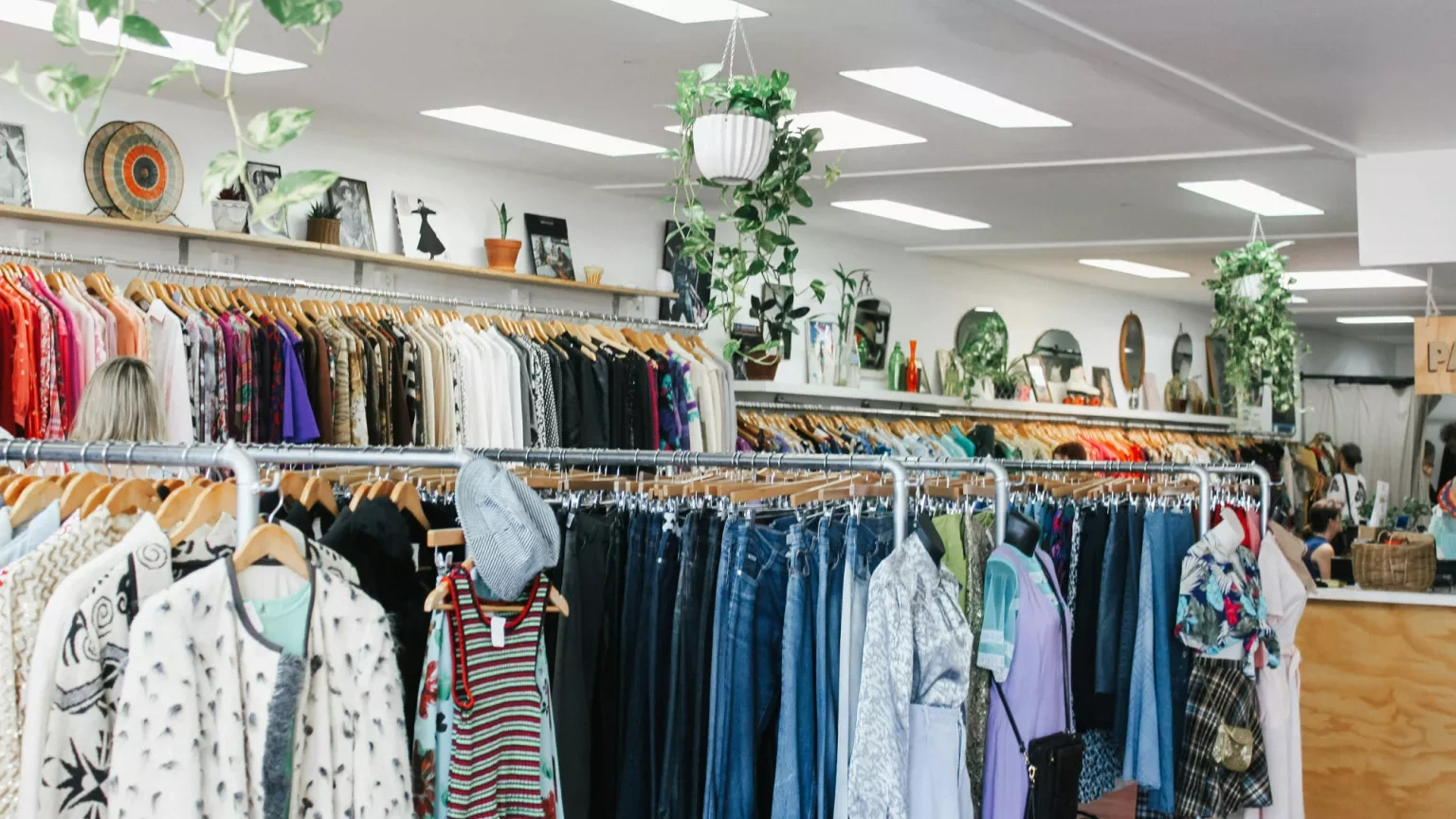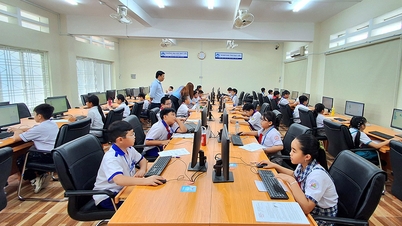Caterina Maestro, founder of fashion rental startup DressYouCan in Milan, Italy, recalls the moment her business idea sparked not from a glamorous runway, but from her own full but always-unfit wardrobe, and her obsession with constantly wearing new clothes.
“It was hard to sustain this habit, both financially and ethically,” she said. The dream of a “shared closet”—a kind of Airbnb for fashion—began to take shape, where people could access designer goods for special occasions at affordable prices.
Caterina’s story is not unique. It reflects a growing trend where consumers, especially younger generations, are increasingly conscious of the environmental impact of fast fashion and looking for alternatives.
Renting clothes has emerged as an attractive option, satisfying the need to “dress well, wear new” while reducing the burden on the planet and wallet. Start-ups such as Rent the Runway, Nuuly, and DressYouCan are quick to seize the opportunity, painting a vision of a sustainable and circular fashion future.
However, the road from idea to success is not paved with roses. Despite attracting great attention and a certain number of customers, most clothing rental companies are struggling to survive, facing the problem of huge operating costs and profit pressure. What are the real barriers that make this seemingly perfect model so difficult to succeed?
The Dark Side of Fast Fashion and the Allure of the Rental Model
The fashion industry has long been identified as one of the biggest polluters of the environment. The statistics are truly alarming. The industry is responsible for around 10% of global greenhouse gas emissions. In Sweden alone, over 90% of the climate impact comes from making clothes and buying new ones.
The problem of textile waste is also getting worse. Every year, the European Union (EU) throws away about 7 million tons of clothing, equivalent to 16kg/person. In the US, the number is even more terrifying: an average of 37kg of textile waste/person/year in 2018, a sharp increase from 13 million tons in 2009 and 9.4 million tons in 2000.
Worse still, according to a 2018 study by moving services company Movinga, Americans throw away 82% of their wardrobes each year. The Clean Clothes campaign found that in Western countries, each person throws away about 70 kg of textile waste each year – about 5% of the world’s total.
In this context, the clothing rental model has emerged as a potential solution. Instead of mass-producing new products, renting helps extend the life cycle of each item.
Professor Frida Lind from Chalmers University of Technology (Sweden), co-author of a recent study on the rental model, asserted: "Many people have clothes hanging in their closets but hardly wear them. Renting clothes will help extend the life cycle of each item, thereby promoting more sustainable consumption."

In the context of the increasingly serious textile waste problem, the clothing rental model has emerged as a potential solution (Photo: Prudence Earl)
The benefits don’t stop at reducing waste. A study published in Women’s Wear Daily found that renting a dress in the US saves 24% of water, reduces energy use by 6%, and cuts CO2 emissions by 3% compared to buying new. While the numbers may seem small, the cumulative impact is huge.
Besides the sustainability factor, the appeal of renting clothes also lies in the economic and experiential aspects. It allows consumers, especially the younger generation like Gen Z (those born between 1997 and 2012), to access expensive branded items and diversify their style without having to spend a huge amount of money to own them.
A dress that costs several hundred dollars can be rented for a fraction of the original price. This is especially true for Gen Z, who “like to change quickly and not be seen wearing the same outfit multiple times,” as Neil Saunders, a retail analyst at GlobalData, puts it. A study by Washington State University found that 55% of Gen Z have rented clothes, in no small part for sustainability and financial reasons.
Model matrix and operating cost burden
When you dig deeper into the operations of rental companies, the picture becomes more complicated. Research from Chalmers University of Technology analyzed nine Swedish companies and identified three main business models:
Library Model: Customers pay a membership fee and can borrow clothes for a certain period of time, similar to borrowing books from a library. This model is often initiated by sustainable fashion enthusiasts.
Subscription Model: Customers pay a fixed monthly fee to rent a certain number of clothes. This is a popular model for large startups like Rent the Runway or Nuuly, which often aim to scale quickly and raise venture capital.
Niche/Occasion-Based Model: Focuses on renting specialized or event-specific apparel, often bundled with other services or equipment, such as ski and snowboard gear, event evening gowns. DressYouCan originally followed this path.
Regardless of the model, most companies face a common challenge: profitability. "We were surprised to see that most of them had difficulty making a profit," admits Professor Frida Lind. "Some companies had to stop operating for various reasons."
The root cause lies in the "hidden" but extremely expensive operating costs. Unlike traditional retail, each rental item requires a complex processing procedure after each use:
Inspection and Repair: Garments must be thoroughly inspected for condition, stains, damage and repaired if necessary. This process is time consuming and labor intensive.
Professional laundry: Ensuring hygiene and preserving fabric quality is a must, requiring expensive industrial laundry processes.
Logistics (two-way transportation): The cost of delivering goods to customers and receiving them back after renting is a significant expense, especially with package rental models that require high shipping frequency.
Warehousing and inventory management: Large storage space and efficient management systems are needed to keep track of thousands of items of different sizes and styles.
Product depreciation: Clothes have a certain life cycle, constant washing and use will reduce their quality and value.

Most fashion rental companies, including giant Rent the Runway, face a common challenge: profitability (Illustration: Getty).
Pippa Stephens, fashion analyst at GlobalData, also highlighted that high delivery, storage and laundry costs make it difficult for many businesses to maintain profits.
Rent the Runway, a major player, is a prime example. Despite an IPO in 2021, the company is still unprofitable and its stock price has plummeted. Nuuly, a service from URBN (the parent company of Urban Outfitters and Anthropologie), will take four years to report its first quarterly profit in late 2023.
Attracting and retaining customers is no easy task. While the rental fee, while cheaper than buying new, can be a burden for some, especially in the face of inflation and rising living costs. Rent the Runway or Nuuly charges more than $90 a month, which is not a small amount. “Some people can’t or don’t want to pay monthly for rental services,” says Neil Saunders.
Finding your own way - niche markets and the power of collaboration
Amidst the challenges, research from Chalmers University of Technology has found some bright spots. Not all models are created equal. Niche-focused companies appear to have a higher success rate.
“Companies that rent outdoor gear and specialized sports gear do better,” says Professor Lind. “They’ve found their niche, where customers have a clear need and are willing to pay for specific uses, rather than a monthly commitment.” Affiliated with tourist destinations, resorts or sporting events also helps these companies reach their target customers more effectively.
Another key factor is close collaboration with stakeholders, especially manufacturers and designers. “Companies that work with manufacturers, especially sustainably oriented brands, get quick feedback on what types of clothes and styles are popular with customers,” Lind shares.
“They also gather valuable information about product quality, such as which parts frequently break after multiple rentals and washes.” This information helps manufacturers improve designs, choose more durable materials, and optimize products for rental purposes, creating a feedback loop that benefits both parties.
Peer-to-peer rental models, where users rent out their own closets through an intermediary platform like Pickle, are also emerging as a potential solution. This model reduces the burden of warehouse management and inventory costs for the platform operator, while creating an additional source of income for clothing owners.
The post-pandemic recovery, coupled with Gen Z’s increasingly sustainable and flexible consumer habits, is fueling the market. The global fashion rental market is expected to reach $6.2 billion by 2024, doubling from 2016, according to GlobalData.

Clothing rental services are being driven by Gen Z's increasingly sustainable and flexible consumer habits (Photo: Getty).
What is the future for fashion rental services to balance sustainability and profitability?
Clearly, the clothing rental model is not a silver bullet that will solve all the fashion industry’s problems. It holds great potential to promote sustainable consumption, but it also faces significant economic challenges.
The future of the industry may not be one model, but a flexible mix. Caterina Maestro of DressYouCan predicts that the market is moving towards a “hybrid” model – a combination of renting, buying new clothes (perhaps basics, essentials) and reselling used clothes. Consumers can rent special, trendy items for specific occasions, while still owning the basics and tapping into the secondhand market to maximize the value of their wardrobe.
For rental companies to thrive, systemic changes are needed. Chalmers’ research suggests that companies should:
Focus on a niche market: Clearly identify customer groups and product types with specific rental needs, instead of spreading yourself thin.
Build strategic partnerships: Work closely with suppliers and manufacturers to improve products based on real-world rental data.
Optimize logistics: Carefully calculate shipping and handling factors from the beginning so you can scale efficiently when needed.
On the consumer side, changing perceptions and habits is crucial. Extending the life of your clothes – whether by renting, buying secondhand, repairing or trading them in – is the most effective way to reduce your environmental impact. If a T-shirt is worn 60 times instead of 30, emissions can be cut in half.
Most importantly, as Professor Lind points out, even if some rental companies don’t survive, these efforts are still valuable. “At the very least, they contribute to changing perceptions of clothing consumption habits and helping society better understand what can and can’t work.” They provide valuable data and lessons for the transition to a more sustainable fashion industry.
Perhaps it will take more time, innovation in management technology, logistics, and possibly policy support, such as financial incentives, for the clothing rental model to truly take off and become a mainstream part of the future fashion industry. The dream of a sustainable “shared wardrobe” is still there, but the path to realizing it will require persistence, creativity, and a more realistic look at the economics.
Source: https://dantri.com.vn/kinh-doanh/dich-vu-thue-quan-ao-tu-do-xanh-hay-cai-bay-dot-tien-20250502000531262.htm


![[Photo] Prime Minister Pham Minh Chinh meets with Hungarian President Sulyok Tamas](https://vphoto.vietnam.vn/thumb/1200x675/vietnam/resource/IMAGE/2025/5/29/dbcaa73e92ea4448a03fe1d0de6d68e8)
![[Photo] Prime Minister Pham Minh Chinh receives a bipartisan delegation of US House of Representatives](https://vphoto.vietnam.vn/thumb/1200x675/vietnam/resource/IMAGE/2025/5/28/468e61546b664d3f98dc75f6a3c2c880)
![[Photo] Vietnamese and Hungarian leaders attend the opening of the exhibition by photographer Bozoky Dezso](https://vphoto.vietnam.vn/thumb/1200x675/vietnam/resource/IMAGE/2025/5/29/94d8ceca5db14af3bf31285551ae4bb3)




















































































Comment (0)